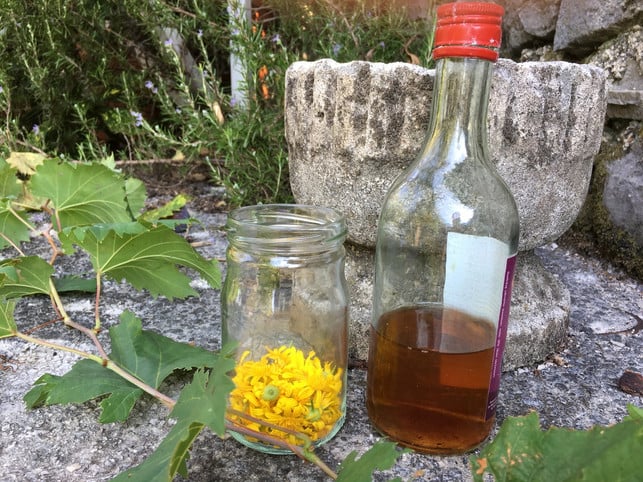
St. John’s wort oil is a natural healing oil for injured skin that can also relieve pain. You can make St. John’s wort oil yourself with little effort.
St. John’s wort oil is a herbal oil that you can use to treat minor skin injuries. The red oil can be obtained from the yellow flowers of St. John’s wort. Its striking color also earned it the popular names red oil or St. John’s blood.
Many people know St. John’s wort as a medicinal tea to relieve stomach problems or as a calming tea. You can also use the fresh flowers to make healing oil for the skin.
St. John’s wort oil: healing oil for injured skin

(Photo: CC0 / Pixabay / NickyPe)
Herbal medicine has been using St. John’s wort oil for centuries, primarily for wound healing. The Pharmacy Umschau lists the traditional areas of application, which are based on experience and only partially proven by medical studies:
- Small wounds and minor burns
- Sprains and bruises
- Muscle pain
The plant substances hypericin and hyperforin are mainly responsible for the effect. According to the yellow list for medicines, hypericin has an antiviral effect and is therefore effective against viruses.
Hypericin and hyperforin are also said to be responsible for St. John’s wort oil having a mood-enhancing effect. St. John’s wort is a herbal medicine that is used for mild depression.
St. John’s wort oil: This is how you make the red healing oil

(Photo: Martina Naumann/utopia)
The petals of St. John’s wort contain fine glands filled with essential oils. You don’t need a still to make St. John’s wort oil. All you have to do is pour oil over the flowers and place them in the sun. In this process, oil extract, the warm oil extracts the active ingredients from the flowers.
For one glass of St. John’s wort oil you need:
-
50 grams of fresh flowers (The active ingredients are particularly intense in summer, but you can also harvest the flowers later and also use the red seed capsules.)
-
200 milliliters of vegetable oil from the organic market. Either olive oil, sesame oil (also online, in the Avocadostore) or wheat germ oil (also online, e.g. at Vekoop).
-
Mason jar with a screw lid (for example a jam jar that holds at least 200 milliliters)
This is how you make St. John’s wort oil:
- Prepare the jar by boiling it to remove germs.
- Pluck the fresh flowers from the stems.
- Fill the glass a quarter full with the flowers.
- Now fill the jar with the oil.
- Close the jar and place it in a warm, but not sunny, place. Because direct sunlight can destroy the active ingredients.
- Now the mixture has to sit for about six weeks. Shake the glass every now and then. The oil should gradually turn red.
- Now you can strain the St. John’s wort oil through a clean cloth and sieve out any flower residue.
- Pour it into a brown bottle (pharmacy bottle). You can also get these online, for example at Avocadostore. The dark color protects the oil from sunlight.
The oil obtained in this way lasts up to a year.
Tip: You can also make larger or smaller amounts of St. John’s wort oil – just make sure that the ratio of oil to flowers is four to one.
St. John’s wort oil: recipe for the impatient
If you don’t want to wait six weeks for the finished St. John’s wort oil, you can shorten steps three to six:
- Grind the flowers with the oil together with a hand blender.
- Warm the mixture in a water bath for about three hours. But be careful not to bring the oil to a boil.
- Then strain the mushy mixture through a clean cloth or coffee filter and fill the oil into dark bottles.
St. John’s wort oil: This is how you use the healing oil

(Photo: CC0/pixabay/Antranias)
You can rub St. John’s wort oil into your skin if you have injured yourself. The oil accelerates wound healing and infections are less likely to occur. However, this knowledge is based primarily on experience. The European Medical Agency began collecting data on how it works in 2021, but it is not yet complete.
Possible areas of application:
- Gently rub closed wounds with the oil every day. This is intended to keep the skin elastic and reduce the risk of bulging scars.
- If you have a minor burn (small first- to second-degree burns), gently rub the area immediately. The redness should decrease more quickly and the pain should subside. Attention: If you have severe, extensive burns with blistering, you should seek immediate medical attention.
-
You can also rub St. John’s wort oil into sores in your mouth. After the dentist has pulled a tooth or when children lose their baby teeth, the oil can soothe the painful area.
You can also use St. John’s wort oil to prepare for birth.
- You can regularly massage the vaginal area and especially the perineum with the oil. This is intended to strengthen the skin and make it more elastic – so perineal tears are less likely to occur.
St. John’s wort oil for skin care:
- If you have neurodermatitis or psoriasis, the active ingredients in the oil can soothe the skin and relieve itching. The skin doesn’t redden as much and flakes less. The University Hospital in Freiburg successfully treated neurodermatitis patients with St. John’s wort oil and cream.
- You can massage a few drops of St. John’s wort oil into damp hair as an oil treatment and rinse after 20 minutes with lukewarm water. It helps with flaky scalp.
- If you have acne, dab some oil on the inflamed area. The anti-inflammatory effect allows the pimple to heal more easily and may leave fewer scars.
St. John’s wort oil: possible side effects

(Photo: CC0 / Pixabay / Ana_J)
Hypericin is not only effective against viruses and germs, but according to the Yellow List it also sensitizes the skin to UV light. St. John’s wort therefore has a potentially phototoxic effect: the skin can sunburn more quickly or become discolored. Therefore, as a precaution, you should not go into the sun if you have applied St. John’s wort oil.
However, the Pharmazeutische Zeitung reports study results that could prove that light sensitivity only occurs with very highly concentrated amounts. The researchers therefore see little danger from sun rays, as the usual dosages in St. John’s wort oil or creams remain significantly below the critical concentration.
Experts also report numerous interactions between St. John’s wort and various medications. Experts warn not to take St. John’s wort with other antidepressants. The hormonal effect of the pill can also be impaired by St. John’s wort.
However, the exact status of the oil is not sufficiently proven and more research is needed.
If in doubt: Get medical advice if you are taking other medication or using the pill – specialists will explain to you whether St. John’s wort oil also affects your medication.
Alternatively, you can also use another body oil. As a healing oil, try peppermint oil, mustard oil or rosemary oil.
Read more on Techzle\.com:
- Apple cider vinegar for skin and hair – this is how you use it
- Make your own skin cream from natural ingredients – this is how it works
- Make your own herb oil: recipe with garlic and rosemary
** marked with ** or orange underlined Links to sources of supply are partly partner links: If you buy here, you are actively supporting Techzle\.com, because we then receive a small part of the sales proceeds. More info.